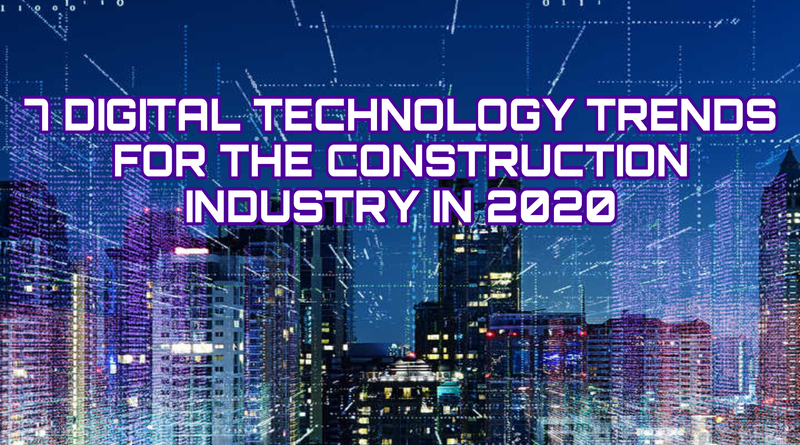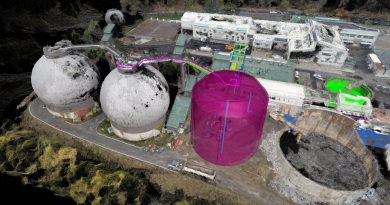7 DIGITAL TECHNOLOGY TRENDS FOR THE CONSTRUCTION INDUSTRY IN 2020
Accelerations in technology are introducing an extensive digital transformation in the construction industry. Today, there are numerous examples of how technology is bringing a revolution in this industry.
Technologies such as Artificial Intelligence (AI) to the Internet of Things (IoT) are dramatically reshaping the construction by driving away long-standing inefficacies, and low productivity.
In this guide, we’ll discuss how the tech trends are transforming the construction business. We will take a look at some construction technology examples and see how they can benefit your construction business.
Before we dive into the details of digital technology trends in construction in 2020 with examples, let’s take a sneak peek at some top trends that you can expect as influencers in construction technology.
According to the McKinsey report, here are some significant influencers.
1. HD Surveying and Geolocation
Projects typically get delayed because of discrepancies in ground conditions.
New techniques that incorporate high-definition photography, 3-D laser scanning, and geographic information systems, and more can improve accuracy and speed.
2. 5-D Building Information Modeling (BIM)
BIM is a digital representation of the characteristics, including physical and functional aspects of a project, which forms a reliable basis for decisions during the project’s life cycle.
With the use of 5-D BIM technology, augmented reality (AR) technology via wearable devices can be further enhanced, which will transform the construction industry
3. Digital Collaboration and Mobility
Digitizing workflows have substantial benefits. Digital solutions for construction need to deliver a seamless real-time experience across facets, such as design management, materials management, scheduling, QC, crew tracking, and more.
4. IoT and Advanced Analytics
In the construction industry, the IoT can allow construction machinery, equipment, materials, structures, and more to talk to a central data platform.
Other technologies, including sensors and near-field-communication (NFC) devices, can monitor productivity and reliability.
5. Future-proof Design and Construction
Building materials represent a $1 trillion global industry. With new building materials, such as aerogels, self-healing concrete, and nanomaterials, can lower costs and also speed up construction, improving quality and safety.
As a construction professional, you’d be interested in knowing how to transform the construction processes using new tech trends successfully.
As CEO of Arabian Construction Company Maher Merehbi says, “In construction, innovations, and improvements are dynamic and happen quite frequently.”
So, you can look forward to incorporating trending innovations, and the McKinsey report has already put forth some of the most exciting trending technologies.
Here’s a roundup of the digital technology trends for the construction industry in 2020 with examples.
Construction Technology Trends: Seven Futuristic Ideas & Examples
1. Augmented Reality (AR)
Augmented reality and virtual reality are technologies that are making crossroads in the construction world. While AR superimposes a computer-generated image on a user’s view of the world, VR can replace the real world through a simulated environment.
However, AR is quickly taking over as an emerging trend with its benefits and uses over VR in the construction arena.
Imagine the power of visualizing the real world through a camera lens. AR systems can display critical information about equipment while the user can look at components or see display warnings when there are risks nearby.
For example, the user can get alerts through the AR lens that can signal surfaces, which are at high temperature or electrically charged.
As buildings are becoming increasingly complex, both AR and VR can facilitate in detecting design and coordination errors. AR can also present BIM data through a next-generation visual platform, which could help in fostering coordination between consultants, designers, and construction teams. So, AR can also be used to discuss projects with clients.
For example, if you have a vacant site, then a completed project can be overlaid on the empty site so that the client can visualize the final result.
Construction professionals can look at new opportunities for the industry, even though it could come at a cost.
2. Building Information Modelling (BIM)
Another hot construction technology trend is BIM that promises to bring in more accuracy to the building process.
BIM will prove to be a game-changer for the construction industry with its ability to depict the project development in an open and highly collaborative environment.
The technology offers several benefits to construction companies, which makes resource management more accessible, enables enhanced collaboration, and helps people stay in touch throughout the project.
The new technology can facilitate in tackling challenges, including budget overspend, QC issues, and project delays. You may come across the latest version called the 5D BIM, which provides shorter project cycles, project scope understanding, and an increase in productivity.
Leading names that have embraced the technology include the Dubai-based architectural firm Killa Design, who have been pioneers behind some of Dubai’s most iconic buildings, such as the Museum of the Future.
Some of the top BIM software solutions available in 2020 include Autodesk BIM 360, Revit, Navisworks, Tekla BIMsight, BIMobject, and BIMx.
In 2020, you will find increased adoption of higher levels of BIM in the industrialization of construction.
3. Robotics
Don’t be surprised if you find robots showing up at your worksites! No, it would not be a sci-fi plot—but an inevitable reality.
You can expect robots to become a commanding force in the construction arena with its offering of precision and accuracy. The cost of robotics may be high at the beginning, but it will be well worth the benefits.
For example, you may witness robots laying bricks and tying rebar or completing man-operated construction projects.
With various types of robots, such as collaborative industrial robots and logistics robots, you can expect more extensive adoption of robotics in construction. So, get ready to embrace robots as they assist in tasks that would take a human worker more effort.
For example, robots lifting heavy objects and placing them in exact coordinates.
4. More Prefabrication, Modularization, and Eco-friendliness
You will witness a growing trend towards multi-trade prefabrication.
For example, In Dubai, construction professionals printed a 3D office building in around 17 days and spent two days on-site assembling it. You can expect prefabrication to save you money. As construction professionals, you can benefit from bulk discounts on materials.
Another added benefit is saving time. With its advantages, professionals have used prefabrication on some of the UAE’s most impressive projects, such as Dubai Mall and Dubai Opera.
Another exciting trend is off-site construction—a.k.a. Modularization, which is quite similar to prefabrication. With its promise of consistent quality and faster construction times, the technology can produce buildings that map up to their traditionally built counterparts.
Another great example, a precast house was built in two days, which is in tune with the Saudi Arabian government stepping up efforts to accelerate innovation and increase homeownership in the kingdom. Modular concrete was used by a local company to build the property (one-story) in Riyadh.
So, progressive construction companies have already started implementing these strategies to run their operations. The standardization offered by the new technology helps to cut down on costs and lead times.
The added benefit of the techniques is that they are eco-friendly because when working on a construction, the extra materials can be easily recycled.
5. Self-healing Concrete
In 2020, you can expect to see self-healing concrete used on buildings, roads, and homes.
Imagine the use of new technology to work on concern areas such as structural deterioration and building cracks. Although, at a nascent stage, the technology could be an excellent solution for such pain points. With concrete as the most widely produced and consumed material in the construction industry, many believe that around 5 billion metric tons per year will be used by 2030.
6. Cloud and Mobile Technology
Cloud operating systems have already been in use in many industries. Today, with mobile devices leveraging cloud technology (anywhere, anytime), you can look forward to storing massive amounts of information, and sharing it instantly.
So, to remain competitive, you may find the need to use a cloud-based business phone system that can easily be accessible.
Cloud solutions can not only facilitate storing large amounts of data but also in making it accessible for project managers, keeping it secure in a remote location. Later, this information can be accessed by connected devices or by data analysis platforms.
So, powerful data processing and storage are just some of the benefits of cloud computing technology, but the latter can be critical for firms to meet their contractual obligations.
Cloud-based Collaborations in Construction Projects
Another dominant trend in 2020 is Cloud-based Collaboration. Effective communication is a prerequisite for the successful execution of any project, and construction projects are inclusive.
With construction projects featured with high fragmentation, and different teams having little or no synchronization, you can expect cloud-based collaboration solutions, addressing the gap efficiently.
With several project participants and teams widely dispersed, it is evident that the project complexity increases and the key to success are effective project team collaboration.
According to a survey report, 87% of the construction industry stated that they were open to using cloud technology for their processes.
In 2020, you can expect developers, engineers, and contractors to easily integrate and manage their existing processes through a single, always-connected cloud-based platform. With cloud-based collaborations, you can also look out for real-time collaboration.
Cloud can help contractors to work on the same sets of data across the back office. And you will find projects running in real-time with accurate data and digitization, eliminating various manual tasks, saving time, providing greater cost flexibility, and improving profitability and productivity.
7. Drones
Drone technology is rapidly evolving, and many construction sites are heavily relying on the use of drones (a.k.a. unmanned aerial vehicles, UAVs).
Goldman Sachs estimates that businesses and government investment on drone tech would reach around $13 billion by 2020. When it comes to drone production, you can expect the commercial development of drones to reach about $10.9 billion by 2025.
And, the drone industry is forecasted to grow to $11.2 billion in 2021.
In the construction industry, the use of drones can facilitate in many ways.
For example, surveyors can survey a site in a fraction of minutes, which traditionally can take weeks or even months. With the advantage of saving time and money, and accuracy and precision, you will find more construction companies who will openly embrace the technology.
Another excellent example, in the UAE, the Abu Dhabi Municipality brought out a pilot scheme to use drones for monitoring engineering work on construction sites.
The system will test the drone’s ability to withstand harsh climatic conditions, which can help to identify the solutions of the technology to support work on the ground.
In 2020, you can expect some incredible digital solutions in the construction industry, so gear up to check out the latest trends and enjoy riding the waves of change.
Source: Imaginovation.net







